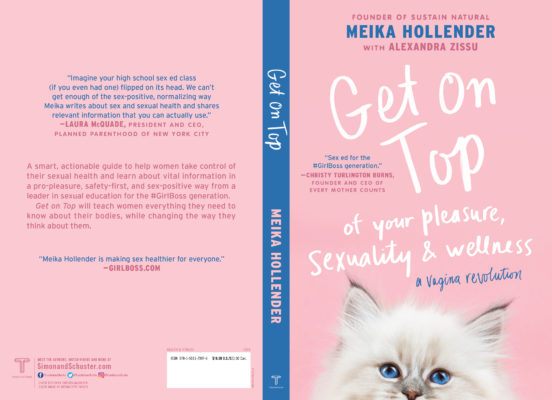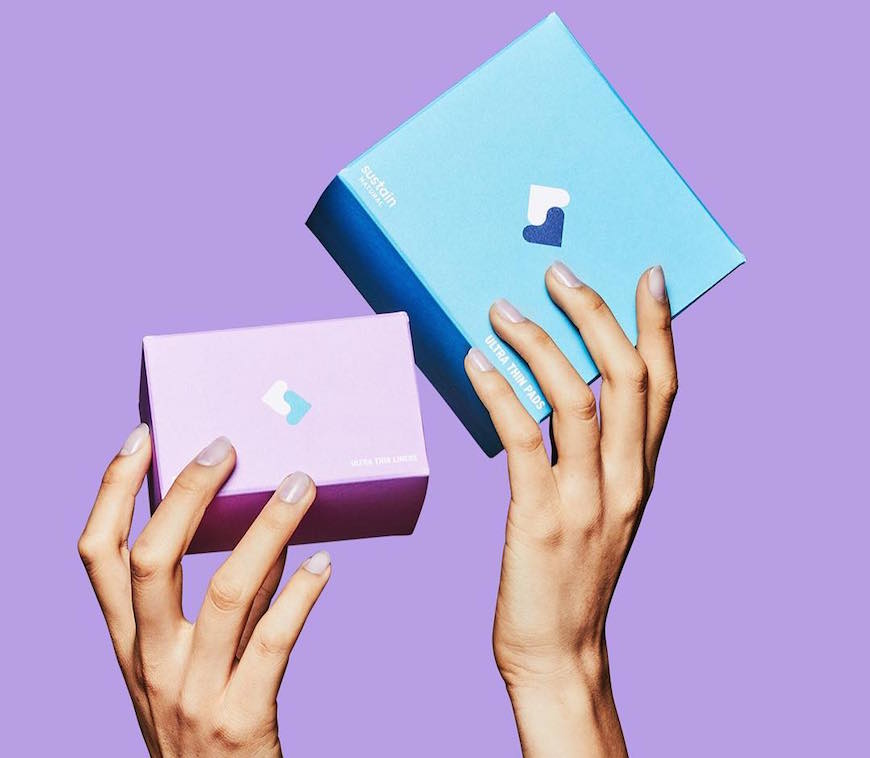How Meika Hollender’s Making a Living by Keeping It Real About Sexual Health
When your father's the co-founder of clean household mega-brand Seventh Generation, you get a head start on education surrounding toxic chemicals and where they reside. You know, like in tampons and condoms, for instance.
Meika Hollender's grown up knowing the impact of said chemicals—so when most people in their twenties were thinking about merely having sex, she was figuring out how to champion a safer sex and reproductive health revolution (and she's still at it).
"One thing I thought was really interesting was that women in particular were leaning towards natural products in skin care, organic food, and cleaning products," says Hollender, who co-founded Sustain Natural. "But when it came to products going into the most absorbent and intimate parts of their bodies, they weren't asking questions about the ingredients. So I saw a huge opportunity to be the first natural sexual wellness brand."
"When it came to products going into the most absorbent and intimate parts of their bodies, [women] weren't asking questions about the ingredients."
Since starting Sustain, which makes non-toxic feminine hygiene products, condoms, and lube, Hollender's been advocating like hell for a more open dialogue about safe sex (case in point: this past Valentine's Day, she put up an entire wall of free condoms in downtown New York with a huge poster that showed a statistic about STDs to help educate everyone who saw it).

"I never thought it was weird or taboo to talk about sex or ask my parents, my doctor, or my partner something—that's how I was raised," says Hollender. "Then, when I started a condom company as a 26-year-old female, I learned very quickly the harsh reality of how people interpret that."
This is precisely why she wrote a book on the very topic, called Get On Top—Of Your Pleasure, Sexuality, & Wellness (out today)—Hollender wants women to have the knowledge necessary in order to own their bodies. With topics ranging from periods, birth control, sex, and self-pleasure, Hollender leaves no sexual topic unturned. "I hope it's one of those things where women don't even know what they don't know to a certain extent," she says. "So when you start reading and learning about your body, it's fascinating and empowering. And I hope it only comes with more pleasurable, consensual, healthy decisions around sex."

{{post.sponsorText}}
Below, Hollender (candidly) answers 3 common questions women have about their period in an excerpt from her new book.

1. I have bad periods and I want to go on the pill to get rid of them. But I hear if you go on the pill, you won't want to have sex. Is that true?
There are plenty of women who say their sex drive feels reduced when on hormonal birth control. Basically when you take the pill, you “turn off” your own cycle and you don’t ovulate. Ovulation is often associated with increased desire—that’s biological. When we release an egg, our libido shoots up; that’s what propagates our species. Our bodies want sperm then. So, if you suppress that process, then libido will be negatively affected. It’s harder to actively want action when your midcycle surge isn’t telling you to look for it. Also, the pill can actually decrease free testosterone in your body, so that could be the culprit. Another thing that can tamp down your desire is if you’re taking the pill back-to-back and don’t get your period at all. Anecdotally, some women say the visual of seeing they’re not pregnant is what gets them emotionally excited to have sex.
"The biggest organ of libido is, after all, the brain—research backs this up."
But here’s the thing: this isn’t always the case for all women. Some people report decreased sex drive because they’re too afraid of getting pregnant. For them, there’s such a huge mental relief to being on the pill that it actually increases sex drive. All of this goes down to the fact that, biology be damned, the biggest organ of libido is, after all, the brain—research backs this up. There are just so many psychological factors that influence our desire. Honestly, you won’t know how you will feel until you’re on the pill. The good news is you can always go right back off it if you don’t like how it’s affecting your libido.
2. What are the clots when I have my period, and what's up with all the different colors—I thought blood was red!
Clots or clumps and a period that ranges from rusty to dark red and pretty much any color in between are both totally normal. Remember, what’s coming out of you is uterine lining, not just blood like what’s in your veins or what you see if you cut yourself shaving. The colors tend to vary with amount of flow and age—it gets darker and browner on your lightest days, which come both at the beginning and especially the end of your period.
The dark color can also mean it’s older blood. Bright red usually happens in the middle of your period when your flow is heaviest and fastest, and it’s the newer uterine lining. Some women with heavy and fast periods only flow red. The clumpy stuff is usually just tissue or menstrual flow with discharge. You know how your blood clots when you cut yourself? Well, during your period there are anticoagulants released that allow your flow to, well, flow. Sometimes if you’re bleeding quickly, it can still clot a little. It’s nothing to worry about. The only time you need to feel concerned is if you’re gushing like a fire hose and soaking tampons or pads at an alarming rate. Then you’ll want to call your doctor.
3. What's the deal with TSS?
That’s toxic shock syndrome and it’s a super rare but potentially fatal disease with some truly horrible symptoms. It’s caused by a bacterial toxin and is associated with tampon use. Young women are more likely to get TSS than older women. If you don’t die from it, you could wind up having to amputate limbs.
But hang on, there’s good news: if you’re changing your tampon regularly, you don’t really need to worry about TSS. Incidences of TSS are incredibly few and far between. They appear to have peaked in 1980, according to the Centers for Disease Control and Prevention (CDC), and have been falling since. This is thanks, in part, to increased FDA regulation of tampon materials (the kinds that are the most ideal breeding grounds for TSS are no longer permitted for use) and the standardization of tampon absorbency across brands.
There has also been an increase in education and labels, including warning labels on tampon packaging. To protect yourself against TSS, wear a tampon that is the lowest possible absorbency level for your flow and don’t leave it in for longer than you should—change it every four to eight hours. Synthetic fibers can be more absorbent than 100 percent cotton but they can also produce toxins from menstrual bacteria, making the risk for TSS higher. (Synthetic [i.e., non-cotton tampons] used to be made from super-absorbent polyester, carboxymethylcellulose, polyacrylate rayon, and viscose rayon, all ideal breeding grounds for TSS. Today only viscose rayon is still permitted for use.)
Whatever you choose to wear, always follow package directions and never wear a tampon between periods. For overnights, if you’re willing to wear pads, period underwear, or a menstrual cup, go for it. If not, use the least-absorbent tampon that works for your flow and don’t forget it’s in there! (Happens to the best of us.) Meanwhile, if you ever experience itching with a sudden high fever, red sores, headaches, muscle aches, vomiting, your skin flaking off, dizziness, or smelling something really off, call your doctor—pronto!
Speaking of sex, here's what you need to know about smart condoms. And this is everything you should know about synthetic birth control.
Loading More Posts...